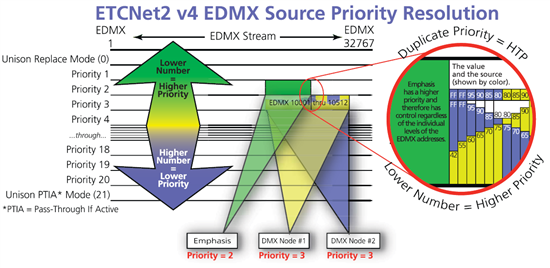ETCNet2 Products
Some ETCNet2 functionality (primarily dmx level data carried as EDMX) is still available in newer ETC consoles like Eos and Congo, but new development work and new features (like ACN compliance and RDM support) are only being added to Net3.
ETCNet2 Versions
ETCNet2 was first introduced in 1997 in the Obsession II console. It went through several iterations of development; in the discussion of ETCNet2 here we will mainly concentrate on Version 4, the final version. Previous versions had limitations with respect to merging and patching that should be noted when working in older systems.
The table below shows compatible versions of software. It is important that versions in a network system match each other, otherwise the system may not work as expected or at all.
| Obsn II | WRFU | NCE | ACN Gateway | Two Port Node | Four Port Node | Video Node | Unison | Emphasis |
|---|---|---|---|---|---|---|---|---|
| 4.4.2 | N/A | 2.0.0 | N/A | N/A | 2.0.1 | 2.0.2 | 1.8b | N/A |
| 5.0.5 | 1.1 | 2.1.1 | N/A | 1.1.0 | 2.1.1 | 2.1.2 | 1.8.2 | N/A |
| N/A | N/A | 3.x | N/A | 3.0.x | 3.0.x | 3.0.x | 1.8.4 | 1.0.x |
| 5.1.x | 4.x | 4.x | 4.x | 4.x | 4.x | 4.x | 1.9.x | 1.4+ |
Newer Net2 products only support the 4.x version of Net2.
ETCNet2 Operation
IP Addressing
Unlike ETCNet(1) which was a raw ethernet protocol, ETCNet2 supports IP addressing of equipment. This means that each piece of equipment must have a unique IP address.
IP addresses may either be assigned statically - meaning you manually assign each piece of equipment an address - or dynamically using BootP - meaning each piece of equipment requests an address from a server as it starts up.
ETC uses a default range of IP addresses for ETCNet2 equipment which can be found here.
ETCNet2 Data Inputs and Outputs
ETCNet2 uses EDMX to transport level data over a network. EDMX allows any amount of data inputs and outputs to a network. Inputs may be from a physical DMX line via a node, or a console or architectural system (which may send more than one universe of data, or data patched to different universes).
Once on the network, data is not divided up by universe; instead it is considered as a single stream of values, ranging from 1 to 32,767. DMX may be output from any contiguous segment of this stream - for example, I could have a DMX output starting at EDMX 500 and running through to EDMX 1012.
Inputs may address a contiguous range of this 'stream', or can also address multiple areas of the stream at once.
Priorities
One consequence of this flexibility is that we can have multiple DMX input streams to a single range of EDMX. In order to decide what to do in this scenario we have a numeric value called a priority which is associated with each EDMX source.
Priority values range from zero to 21, with 0 being the highest priority (will always have control) and 21 being the lowest (will give up control most easily). The default for most sources is 10.
If there are two sources trying to address the same range, and those two sources have the same priority, those sources will merge in a highest-takes-precedence (HTP) fashion.

ETCNet(1) Mode
ETCNet2 nodes also have an ETCNet(1)mode that allows them to operate with Net1 equipment. When operating in Net1 mode, the devices have only the capabilities provided by the Net1 protocol and the console supplying the data. (e.g. No DMX inputs and an express console only outputs video for one monitor.)
ETCNet2 products include :
- ETCNet2 Four Port DMX Node
- ETCNet2 Two Port DMX Node
- ETCNet2 Video Node
- ETCNet2 Network Configuration Editor (NCE)
